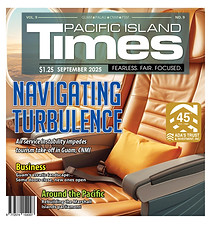US Coast Guard sets Guam and CNMI ports to Heavy Weather Condition Zulu amid tsunami advisory
- Admin

- Jul 30
- 2 min read

(US Coast Guard Forces Micronesia)-- The U.S. Coast Guard Captain of the Port set Guam and the Commonwealth of the Northern Mariana Islands ports to Heavy Weather Condition Zulu on Wednesday, July 30, as of 2 p.m., affecting commercial vessels at or over 200 gross tons, in response to a tsunami advisory triggered by a major earthquake off Russia's Kamchatka Peninsula.
The U.S. Coast Guard cutters and small boats are underway to ride out the event offshore, which is safer than remaining in port and risking being set aground. They will return after any impacts.
Shore based Coast Guard crews evacuated from the primary footprint which is close to sea-level and reconvened at a preidentified alternate site on higher ground.
The radio watch is transferred to stateside colleagues, and actively crewed, listening to Channel 16. The commander of Forces Micronesia/Sector Guam established an Incident Management Team to handle the event and conduct assessments once any potential waves pass.
The Captain of the Port is actively communicating with port partners to ensure the safety of the port and facilitate a smooth resumption of commerce following the event.
The U.S. Geological Survey recorded the earthquake with a preliminary magnitude of 8.0, later upgraded to 8.7. The quake struck 133 km southeast of Petropavlovsk-Kamchatsky, Russia, at a depth of 74.0 km, at 9:24 a.m. ChST.
Port Heavy Weather Condition Yankee, set by the Captain of the Port, signals that hazardous conditions, such as strong ocean currents and sea level fluctuations. This affects commercial vessels at or over 200 gross tons, which must cease cargo operations and leave the ports, with no new vessels permitted to enter.
The Captain of the Port anticipates setting Port Heavy Weather Condition Zulu at 2 p.m., the ports and marinas will be closed to all traffic. No maritime related terminal, facility, vessel or marina operations will be permitted.
Available data indicates a potential threat to Guam, Rota, Tinian and Saipan from sea level fluctuations and strong ocean currents, posing hazards along beaches, in harbors, and in coastal waters.
Hazardous sea level fluctuations and strong currents could begin as early as 2 p.m. ChST in Guam, Rota, Tinian, or Saipan.
Residents are advised to stay out of the water and move at least 100 feet inland and 50 feet up from beaches and harbors.
Tsunami safety measures include avoiding low-lying coastal areas, following evacuation orders if issued, and monitoring updates from local authorities, as waves may arrive in sets and persist for hours.
U.S. Coast Guard cutters and small boats are getting underway as needed to ride out the event offshore, where it is safer than remaining in port and risking being set aground. They will return after any impacts and be ready to conduct assessments and surveys of the coasts and ports.





